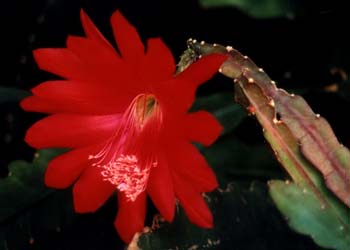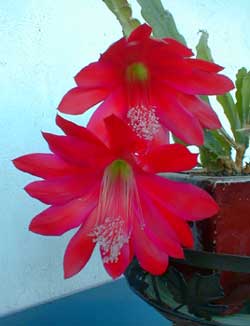 Single Red
Single Red
Epiphytic
Orchid Cactus #3
There are three orchid cacti sitting on a table in a shaded window location, huge one, big one, & little one. This is the little one, though only the leaves are smaller; the flowers are just as big on all three.
They do not bloom simultaneously. The biggest blooms in May; the middle-sized one blooms in June; this small one blooms mid-July to mid-August.
This one is a bit different, too, in that the long leaves are not flat, but have three edges. The leaves are a foot tall & it does not generate new leaves nearly as quickly as the others. Three years running since 2002, it only produced two of these big-as-your-hand blossoms each year.
 In 2002 this orchid Cactus became ill & some of its leaves softened & died, though I could not see any change in my care & had not overwatered it.
In 2002 this orchid Cactus became ill & some of its leaves softened & died, though I could not see any change in my care & had not overwatered it.I feared a root disease, but removed the worst of the leaves, put it in a less sunny location, watered it sparingly, & it began to recover without further treatment. It started 2003 with a few new leaves, & a few more by 2004. It had not in that amount of time quite regained its former size before so much of it got sick & died. I never figured out what had gone wrong with this specimen, though I may have overwatered it during its summer rest period. I felt merely lucky that it recovered, as I hadn't really done much to help it revive.
Orchid Cacti have growth spurts in spring & autumn, but are quiescent in winter & summer. This one blooms so late that its post-bloom summer rest is pressing up against autumn.
As long as one-third to two-thirds of the soil is holding some moisture, however, it does not need rewatering; waterings should be very thorough but not too close together. During their growth periods Orchid Cacti need more water, & their medium should not dry out entirely, though certainly it should never be soppy. The leaves may get a little "wilty" during post-bloom or in summer, but do not imagine this is because it wants more water, or you'll drown it. The wrinkly or wilty bits are from the stress of having expended so much energy blooming, & it needs at mist the same amount or even less water during its recovery period. In winter it needs even less water, just enough to keep it from drying out entirely.
A monthly low-nitrogen liquid fertilizer (any good cactus fertilizer will do) begins in spring & continues until the first month of autumn. Do not give it any fertilizer between November & March. When it's time to start the monthly feedings, if you have on hand a fertilizer that has more nitrogen than is good for cacti, you can dilute it to half strength or weaker & it will be suitable. In general, under-fertilizing is safer than over-fertilizing, but for best flowering each year orchid cacti do need to be fed.
Go to
First Orchid Cactus
First Orchid Cactus